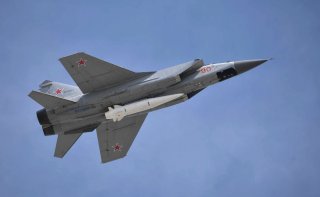Russia’s Tactical Nuclear Weapon Stockpile Is Jaw-Droppingly Large
At around 3,000 to 6,000 units, the Russian Federation possesses the largest tactical nuclear weapons stockpile in the world.
Here’s What You Need to Remember: The underlying purpose of Russia’s tactical nuclear arsenal is rather more mundane but no less impactful. The Kremlin, with its relatively limited resources, is unlikely to win in a prolonged, conventional, continental war with NATO. Thus, Russian military doctrine sees tactical nuclear warheads as a hedge against NATO.
At a meeting with Russia’s defense industry and top military brass, Russian President Vladimir Putin extolled the progress made under Moscow’s sweeping military modernization programs: "the latest weapon systems and military hardware are intensively arriving for the Army and the Navy, the potential of the nuclear triad has strengthened substantially and the Navy has expanded its combat capabilities…” Putin added that “It is important to keep the required pace of producing advanced strike systems for the purposes of their employment and testing in the course of intensive combat training.”
The composition of Russia’s military has changed significantly in recent decades, with several of its service branches undergoing a post-Soviet transition into a lean, heavily modernized fighting force. But if there is one aspect of Russian military planning that’s unlikely to shift anytime soon, it's Moscow’s continued reliance on tactical nuclear weapons as a core deterrent against the North Atlantic Treaty Organization (NATO). Here is the extent of Russia’s tactical nuclear arsenal, and how Moscow plans to use it in the event of a major armed conflict with the west.
It should be noted that there is no universally accepted distinction between “tactical” and “strategic” weapons. There is at least some legal precedent, however: for arms control purposes, Russia and the U.S. typically define non-strategic nuclear weapons as those with a striking range of less than 5,500 km. More generally, a strategic warhead is understood to be a weapon used against infrastructure like factories, energy production facilities, cities, etc. to target the underlying sources of an enemy’s military power. On the other hand, a tactical warhead is used on a battlefield to affect immediate consequences in an ongoing military engagement.
At around 3,000 to 6,000 units, the Russian Federation possesses the largest tactical nuclear weapons stockpile in the world. These include not only warheads inherited from the Soviet Union but new and potent weapons systems developed in recent years.
As Putin acknowledged at his recent defense conference, a great chunk of these tactical weapons are operated by the Navy. “The latest weapon systems and military hardware are intensively arriving for the Army and the Navy, the potential of the nuclear triad has strengthened substantially and the Navy has expanded its combat capabilities, especially with warships carrying Kalibr cruise missiles,” he said. Notable carriers for these weapons include the new Yasen nuclear-powered cruise missile submarines and Admiral Gorshkov class frigates. The Air Force’s Tu-22M3M modernized bomber and modified MiG-31K interceptor carry the hypersonic, nuclear-capable Kh-47M2 Kinzhal missile, posing a credible threat against high-profile NATO military assets like carrier strike groups (CSG’s). The Russian Ground Forces’ recent Iskander-M short-range ballistic missile system can also accept nuclear warheads.
So, what does the Kremlin need all these nuclear warheads and advanced systems for?
Citing Russia’s supposed strategy of “escalate to de-escalate,” some observers have inferred offensive intent behind Russia’s tactical nukes; according to this line of reasoning, the Kremlin can seize a disputed territory and then quickly launch a preemptive tactical nuclear strike against nearby NATO assets to force the west into a diplomatic settlement. But, as I explained in-depth in a previous article, there is no evidence that the Kremlin is entertaining any such grand plans of conquest; the concerns behind “escalate to de-escalate” have been greatly overblown.
The underlying purpose of Russia’s tactical nuclear arsenal is rather more mundane but no less impactful. The Kremlin, with its relatively limited resources, is unlikely to win in a prolonged, conventional, continental war with NATO. Thus, Russian military doctrine sees tactical nuclear warheads as a hedge against NATO--not only a deterrent but one of Russia’s only means of leveling the playing field in the mutually undesired event of an all-out war. As costly as these stockpiles are to store and maintain, it would be exponentially more expensive-- and ultimately futile, given the financial disparities between the two sides-- for Russia to try to match NATO’s conventional strength. Tactical nuclear warheads are, and will likely continue to be, a cost-efficient way for Moscow to offset its disadvantage in this domain.
Mark Episkopos is a national security reporter for The National Interest.
This article is being republished due to reader interest.
Image: Wikimedia Commons/kremlin.ru.

